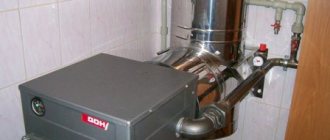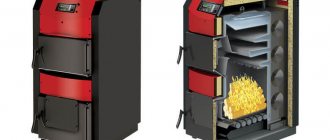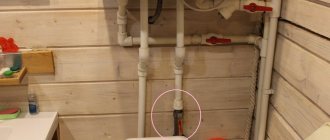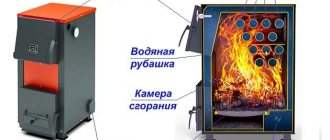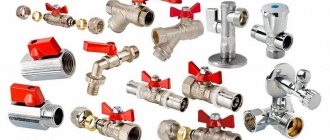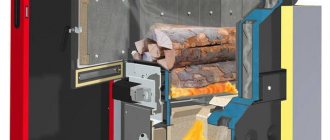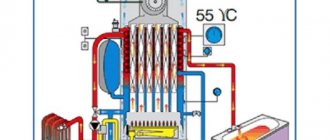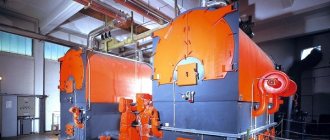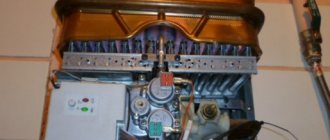Home / Boiler rooms
Back
Published: November 30, 2019
Reading time: 2 min
0
768
Although infrequently, news about exploding boilers still appears in emergency reports from time to time. And what’s most interesting is that the reason is not always a faulty stove or an unextinguished cigarette.
It also happens that the heating boiler becomes the culprit. We are accustomed to the fact that all devices whose names contain the word “industrial” are used in manufacturing enterprises, on the territory of factory workshops and large workshops.
In fact, this is not always the case. Companies involved in the production of heating equipment offer consumers large installations for autonomous heating of apartment buildings.
Consequences of a boiler rupture
And although they are used in residential buildings, they are still called industrial. The reason is the high power, which is quite enough not only for a multi-story building, but also for a warehouse and a large production line.
But they also tend to fail. The only problem is that the consequences can be dire.
- 1 How does an industrial boiler explode?
- 2 Safety precautions
Can a modern gas boiler/heater explode?
Theoretically, for a vehicle to explode, the following reasons are necessary:
- The empty pipe is heated without coolant.
- The water in the radiator does not circulate, but stands and boils to critical temperatures.
Both are impossible, because even the cheapest Economy Class speakers have a security system installed. Empty pipes will not heat up because until you open the faucet to supply water, the burner will not start. And as soon as you close it, the heating will stop.
The heating temperature and liquid flow rate are controlled by special sensors. All models are equipped with these sensors:
- Thermal sensor. Monitors temperature rise. As soon as the water heats up to the set value, it sends a signal to the main module and it turns off the heating.
- Flow sensor. Fixes the pressure speed in pipes.
- Flexible diaphragm. Serves to open the gas valve. If the pressure in the line is sufficient, then the membrane bends and fuel enters the burner. As soon as the pressure decreases, the membrane returns to its original position and the gas supply stops.
- Ionization sensor. If the flame in the burner goes out, the sensor sends a signal to turn off the equipment.
- Exhaust product sensor. Reacts to the lack of draft in the chimney. Ideally, smoke should exit normally through the smoke shaft. If this does not happen, protection is triggered. Did you hear that it smells like burning? Then check the chimney. If there is a blockage, the shaft is cleaned.
Smell of gas from the boiler in the house? Close the shut-off valves and call the gas service to check.
Danger arises when the operation of equipment gets out of control.
What experts recommend doing to avoid emergency situations:
- Buy heating equipment only in specialized stores. Get a guarantee so that in case of a breakdown you can contact a service center.
- Trust the connection to specialists.
- Carry out breakdown prevention and maintenance once a year. Clean components and parts from scale, soot and blockages.
- If problems are observed during ignition (the column bangs or slams), be sure to contact a specialist.
Any technique can be dangerous if used incorrectly. Monitor the operation of your devices, then you won’t have to deal with the consequences.
The operation of gaseous fuel boilers requires great skill and attention from drivers (operators). Inattention or error when maintaining the combustion mode can lead to serious consequences. The driver must know and take into account the dangerous properties of flammable gases, i.e. their explosiveness.
The most common reasons for the formation of an explosive concentration of a gas-air mixture can be: insufficient ventilation of the firebox and flues; supplying gas to the burner before the introduction or formation of a pilot flame; failure of the flame of a portable ignition device in the firebox when the burners are turned on; an attempt to ignite an adjacent burner from a working one without using a pilot torch; restarting the burners after the pilot or main flame fails without preliminary ventilation of the firebox and flues; incorrect or premature opening of taps in front of the burners; improper purging of gas pipelines before putting the boiler into operation.
The causes of explosions and gas contamination when burner devices are turned on are also: a malfunction of the igniter or its incorrect installation; errors by maintenance personnel in fixing the position of the gas shut-off valves and their leakage; turning on burner devices when automatic flame control is disabled or faulty; incorrect assessment of instrument readings or their malfunction.
During operation of the boiler, the reasons for the extinguishing of the torch, gas contamination of the furnace and an explosion from the hot surfaces of the lining can be: a short-term interruption of the gas supply; flame failure as a result of a sharp increase in vacuum in the furnace; extinguishing of the torch in cases of malfunction of the gas pressure regulator or gas-air valve, clogging of the gas outlets, stopping of the smoke exhauster or fan, as well as incorrect actions of personnel when regulating the thermal power of the burners.
Even minor gas leaks in a poorly ventilated area can create explosive mixtures.
The lack of odor in gases that do not contain mercaptan-sulfur, as well as color in all hydrocarbons, creates difficulties in the timely detection and elimination of possible gas leaks.
Therefore, gas is given an odor by adding sharp substances, in particular ethyl mercaptan C2H5SH, in order to detect leaks. This process is called gas odorization. The smell of odorized gas should be felt when its content in the air is approximately 7b of the lower explosive limit of the gas.
Due to the fact that the density of air is 1.293 kg/m3, and natural gas, depending on the content of components, is about 0.8 kg/m3, in case of leaks, gases will leak out. particles will accumulate in the upper parts of the room (since they are lighter than air), making them difficult to detect.
Gas fuel is burned in boiler furnaces using burner devices.
The quality of operation of gas burner devices is assessed by the completeness of gas combustion. To determine the completeness of gas combustion, various instruments are currently used: gas analyzers (VTI, GKhP-100), chromatographs (GSTL, Gazokhrom-3101), etc.
To ensure reliable and safe operation of burner devices, gas fuel of various types must comply with state standards and meet the following basic requirements: contain as little as possible the amount of harmful and ballast (non-burning) impurities; have a constant composition of components and, accordingly, have a constant calorific value; contain a minimum amount of oxygen and air, which contribute to corrosion of the internal surface of gas pipelines.
In the event of an incorrect operating mode of gas fuel boilers, i.e., in the event of a violation of combustion stability (flame separation or breakthrough during sudden changes in operating modes, malfunction of gas burners, draft and stabilizing devices, damage to gas ducts and air ducts, etc.), in their furnaces , flues and hogs, under certain conditions, an explosive gas-air mixture can form. If its temperature reaches the ignition temperature, then, regardless of whether this happened in the entire volume or in a limited part of it, an explosion of the mixture is possible.
For most flammable gases, the ignition temperature is the temperature of an open flame of various origins: a match flame, an impact or electric spark, a lit cigarette. Thus, the ignition temperature of the gas-air mixture of methane is 645 °C, propane is 490 °C, butane is 475 °C.
The accumulation of flammable gases in furnaces and flues and the formation of an explosive mixture most often occur when gas leaks from gas pipelines into the furnace through gas burner devices due to leaks in shut-off valves, violation of the procedure for purging gas pipelines and igniting burners, and other violations of operating instructions.
The most responsible from a safety point of view is igniting a cold one. This especially applies to boilers that do not have smoke exhausters or blower fans. Ventilation of fireboxes and flues in them occurs only with the help of the vacuum created by the chimney. When the boilers are not working, the value of this vacuum is close to zero and it takes a long time to ventilate the flues and ducts of the boiler room. In addition, it is necessary to check these volumes using instruments for the absence of gas contamination.
Examples of accidents associated with the combustion of gas fuel
On the DKVR-6.5/13 boiler, when the boiler was fired up after a five-hour standby period, an explosion of the gas-air mixture occurred in the firebox and flues. As a result of the explosion, the lining was destroyed, the frame, front plate, pipelines in the boiler area, economizer lining, and glazing of the boiler room were deformed.
The cause of the accident was non-compliance with the instructions: the operator brought the lit igniter into the combustion space without ventilating the firebox and flues and without checking the tightness of the shutdown devices. The taps in front of one of the burners were not tightly closed, and gas through them filled the combustion space.
The operator stopped and started the boiler without a written order from the supervisor responsible for the safe operation of the boiler and gas facilities. Earlier, on the same boiler, an explosion of the gas-air mixture occurred due to the disconnection of the remote control of the automatic safety devices of the “Crystal” system. The actuators were deliberately disabled, and when the smoke exhauster and fan were turned off, gas contamination of the firebox occurred.
The failure of the DE-25-14GM boiler in a new boiler room occurred during the commissioning period due to an explosion in the firebox and gas duct of the gas-air mixture.
The boiler room staff was led by the foreman of the adjusters group. Due to the lack of water in the deaerator, the operator stopped the boiler. After eliminating the fault in the feedwater line, the operator, at the direction of the adjusters, began igniting the boiler. Having previously ventilated the firebox a little, I adjusted the vacuum and began to adjust the gas pressure. At the hydraulic fracturing site, I cocked the PKV valve (high pressure safety valve), adjusted the RDUK2 pressure regulator (Kazantsev universal pressure regulator) to a pressure of 0.03 MPa, cocked the PKN valve (low pressure safety valve), opened the valve at the gas inlet to the valve, then checked that the valve in front of the gas burner is closed.
The operator then opened the valve on the igniter gas line and turned the key on the control panel to apply voltage to the central electrode of the igniter. On the first attempt, the gas in the firebox did not ignite; when the ignition coil of the electric igniter was turned on again, an explosion followed.
As a result of the explosion, the casing of the boiler and economizer was partially damaged, a gas pipeline with a diameter of 150 mm from the collector to the burner was deformed, the frontal lining and about 85% of the window glazing of the boiler room were destroyed.
The investigation established that the valve on the lower pipe was open for one revolution of the rotation of the rod, and under the valve shut-off member there was a melted piece of metal from electric welding, as a result, gas entered the furnace and gas ducts of the boiler before it began to light up, and during the kindling, from - due to insufficiency, which led to an explosion of the gas-air mixture after a spark appeared between the electrodes of the electric igniter.
The accident could have been avoided if the duration of pre-start ventilation of the combustion chamber and flues had corresponded to that specified in the instructions.
NOTE: It is strictly prohibited to go into the workshop until the damaged steam pipeline is disconnected and steamed. If fistulas or leaks and steam are detected in the fittings, the workshop shift supervisor must immediately identify the dangerous area and fence it off to prevent people from entering this area. In a hazardous area, stop all work, constantly monitor the damaged area, monitor the level in the drum and the pressure in the steam line. The shutdown time of the unit is determined by the chief engineer of the station.
15.
EXPLOSION IN THE FIRES OR GAS FLUE OF THE BOILER
A) SIGNS of this a.s. is:
A characteristic sound in the area of the accident, destruction of the lining of the boiler.
Poor ventilation of the furnace and boiler flues before lighting or after shutdown;
Extinguishing of the torch in the boiler furnace;
Leakage of fuel fittings in front of the burners;
Violation of the combustion regime (incomplete combustion of fuel due to insufficient air, poor mixing of fuel and air).
C) PERSONNEL ACTIONS:
Emergency shutdown of the boiler and unit;
Check the execution of operations to stop the unit according to point 3;
Ventilate the furnace and boiler flues for 10 minutes. in the absence of combustion sources in the furnace and gas ducts;
Find out the cause of the explosion;
Inspect the boiler in order to determine the magnitude and nature of the damage, close the peek-a-boo hatches and manholes that could have opened during the explosion, inspect the condition of the boiler lining and the lining of the gas ducts.
You can start lighting the boiler only after identifying and eliminating the cause of the explosion and eliminating the consequences of the explosion with the permission of the chief engineer.
16. IGNITION OF TAIL HEATING SURFACES OF BOILERS
If there are signs of a sharp increase in the temperature of the flue gases or the temperature difference between gas and air, operating personnel are obliged to:
Immediately turn off the boiler;
Turn off the draft machines by closing their guide vanes, excluding ventilation of the firebox and flue ducts;
A conclusion about the cessation of combustion can only be made after a thorough internal inspection of the heating surfaces and flues;
Enable all types of internal fire extinguishing and washing of TVP;
Ensure abundant external irrigation of the gas duct (air duct) and water supply through hatches directly onto burning surfaces using fire nozzles using our own operational and maintenance personnel, as well as with the involvement of fire departments;
Pump water through the economizer and create the necessary flow of accumulated steam through the superheater by opening the purge into the atmosphere to prevent their damage.
17. FIRE IN THE SHOP
A) SIGNS of a fire are:
Heavy smoke in the workshop;
Flame within the workshop.
B) CAUSES of a fire can be:
Explosion or bang in the firebox;
Short circuit in the electrical cable or motor;
Violation of fire safety rules in the workshop.
C) PERSONNEL ACTIONS:
If a fire is detected, act in accordance with the general facility instructions for preventing and extinguishing fires and the operational fire extinguishing plan;
In the event of a fire that threatens the lives of personnel or equipment, as well as the remote control circuits of the shutdown valves included in the protection circuit, immediately turn off the boiler and unit. Check the execution of operations to stop the unit according to step 3.
18. INCREASING LIVE STEAM PRESSURE AFTER THE BOILER
A) Signs of this AS, determined from the readings of panel devices, may be:
Operation of PS ROU at a steam pressure in front of the turbine of 143 kgf/cm 2 ;
Opening of control pulse safety valves when the pressure behind the boiler increases to 155 kgf/cm 2 ;
Opening of working pulse safety devices when the pressure in the boiler drum increases to 172 kgf/cm 2.
B) THE REASONS for this a.s. can be:
A sharp increase in frequency in the system (load shedding);
Poor performance of the turbine control system;
Malfunction of thermal load regulators or fuel regulators.
2017-06-23 Evgeniy Fomenko
What to do if the wind blows out a gas boiler with a coaxial (side) chimney
Eliminate and prevent icing
Ice forms not only on the headband, but also up to a certain point deep into the chimney. The problem is inherent in all wall-mounted or parapet convection gas boilers and occurs due to a large temperature difference when combustion products, including water vapor, are discharged outside where the air temperature is much below zero.
Steam settles on the walls of the inner pipe in the form of condensate, which freezes and narrows the cross-section of the pipe, interferes with normal draft and can even cause turbulence or oxygen starvation of the combustion chamber.
It is quite simple to temporarily fix the problem; just carefully, without damaging the chimney, knock off the ice. For complete prevention, you need to insulate the outer part of the coaxial chimney or use a special anti-icing design.
Installation of a specially designed deflector
In general, a gas boiler with a closed combustion chamber rarely goes out in strong winds. In such models, thrust is provided forcibly and the wind pressure from outside is simply not enough to create reverse thrust. But still, the reason why a gas boiler blows in the wind, as in the case of a vertical chimney, may be the absence of a protective deflector, the presence of nearby buildings and objects that create strong turbulence, or the windy side in regions with strong gusts. Blowing occurs through the air intake pipe.
Coaxial model Bosch 600/3 with factory wind protection.
Deflectors for coaxial chimneys are almost never sold separately. If your chimney does not have reliable protection, you need to purchase a full-fledged structure, since for coaxial chimneys the protection is developed taking into account the design and characteristics of the chimney itself.
Homemade protection against blowing by gusts of wind
If none of the above helps, among special craftsmen there is a method for creating homemade cylindrical protection:
- To enhance draft and prevent the formation of condensation, you need to insulate the outer pipe.
- A 90° elbow directed upwards is placed on the inner (exhaust) pipe.
- The chimney is placed in a cylinder (homemade or ready-made barrel) with a hole in the front with a diameter equal to the diameter of the chimney. It protects the exhaust from cross winds and the 90° elbow protects from inward winds.
- The exhaust elbow is led upward, through the cylinder, and is covered with a conical cap of larger diameter (similar to the Grigorovich deflector used in the design), which protects from precipitation.
As a result, air is taken from the inside of the protective cylinder (barrel), and exhaust is produced upward.
Despite the fact that such home-made structures have already been encountered in practice, we do not recommend resorting to making them yourself without certain knowledge and skills. For these purposes, it is better to contact specialists or purchase a ready-made coaxial chimney with factory wind protection.
Gas boilersChimneysInstructionsBoilers
Why the boiler smokes reasons
Let's figure out why the boiler smokes and what are the main possible reasons for this phenomenon. Most likely the problem is in the chimney.
Here is a list of supposed malfunctions in this unit leading to poor traction:
- The chimney pipe is clogged. In winter, it could get snowy or freeze. Also, a foreign object could get there from above or soot could gradually accumulate. All this can be the reason why there is no traction.
- When burning wood that is not sufficiently dried, tar accumulates, which greatly narrows the diameter of the pipe and increases the thickness of its walls, preventing it from warming up sufficiently.
- The diameter or type of chimney does not match the power of the model.
- Insufficient height at which the pipe ends. In this case, the pressure difference will not be enough to produce natural traction.
- Crack or leaking joints in the chimney. Too sudden changes in direction and turns of the pipe, where plugs of cold air form.
A sudden change in weather may also be the cause. During the cold season, the craving is stronger than at high temperatures. When there are strong gusts, the wind blows from above into the pipe.
Unsuitable or poor quality fuel also causes smoke. For example, gas with a large number of impurities, wet firewood, foam or other synthetic materials entering the solid fuel boiler
You should also pay attention to the degree of opening of the gate
Smoke comes into the room if air does not enter the boiler room when the boiler is operating. For safety reasons, there must be an air supply from the same side of the house as the chimney. Otherwise, strong wind can lead to a pressure drop and the formation of smoke inside the room.
A clogged boiler or a reduced flow area of the grate can also cause smoke. The device also smokes at the very beginning during kindling, due to the fact that the chimney pipe has not yet heated up.
The pressure in the boiler exceeds the permissible
It is necessary to constantly monitor the pressure in the boiler
The most common cause of explosion of solid fuel boilers is excess pressure, which occurs due to boiling of the coolant. This is especially true for heating systems with a closed type expansion tank. When the expansion tanks are open, excess pressure is released into the tank and in most cases it is possible to avoid a boiler explosion or damage to the coolant tubes. In turn, there are several reasons for increasing coolant pressure:
- Stopping the circulation pump.
- The boiler automation is not adjusted correctly.
- Heat exchanger leakage, which occurs when microcracks form in the heat exchanger. In this case, it is difficult to detect the leak as it evaporates quickly.
- Water seeping through the make-up tap. Occurs when it is faulty or open.
- Three way valve problems. The functionality of the valve is impaired due to its blockage.
- Lack of coolant in the heating system
If eliminating the above reasons does not give the desired result, call a gas technician.
